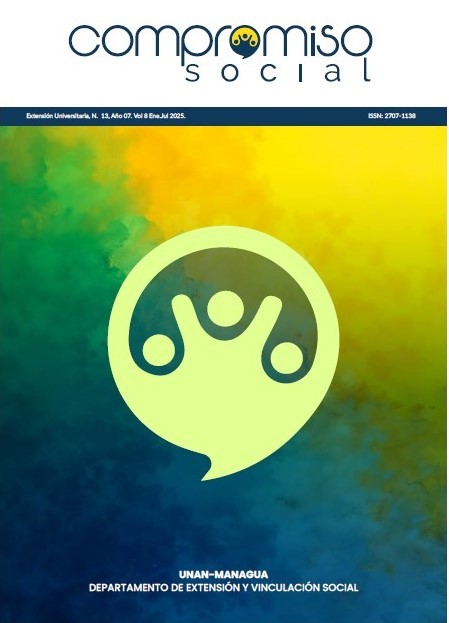Contributions of biotechnology to environmental regeneration for sustainable development
DOI:
https://doi.org/10.5377/recoso.v8i13.20585Keywords:
Bioremediation, bioprospecting, immobilization, phytoremediationAbstract
This article summarizes the results of studies carried out by a team of researchers from different areas of the Biotechnology Research Center (CIB/UNAN-Managua). The research began with a physical, chemical and microbiological characterization of sediments and water in sites exposed to contamination as a result of artisanal mining and tanning activities. By summarizing these findings, it is possible to visualize that through the action of microorganisms it is possible to propose alternatives to the identified environmental problems. For this reason, emphasis is placed on the methods used during its implementation and its main findings. The CIB/UNAN-Managua aims to design Bioremediation technologies, which are non-invasive and are considered environmentally friendly while contributing to the fulfillment of the Sustainable Development Goals. The results suggest that fungal consortia isolated from mining deposits could be used to remove metals; according to the researchers, removal could be greater if phytoleaching is used. Microorganisms isolated from used vegetable oil could be used in the treatment of wastewater with high concentrations of oils and fats. It is important to mention that the execution of these restoration actions significantly links the university and the state.
Downloads
References
Areas Bermúdez, V. M., y Herrera Gutiérrez, B. J. (2015) Evaluación del potencial de fitorremediación de Paspalum conjugatum P. J. Bergius y hongos autóctonos en sedimentos contaminados por metales y metaloides del Botadero La Estrella, Santo Domingo, Chontales. [Tesis, Universidad Nacional Autónoma de Nicaragua, Managua]. http://repositorio.unan.edu.ni/id/eprint/13742
Casas-Martínez, Y. D. P., Fuquen-Fúquene, I. T. y Gómez-Rodríguez, A. M. (2022). Avances en biotecnología ambiental: biorremediación de plásticos. I3+, 4(2). https://doi.org/10.24267/23462329.939
Chicaiza-Ortiz, C. D., Rivadeneira-Arias, V. del C., Herrera-Feijoo, R. J., y Andrade, J. C. (2023, May 10). Biotecnología Ambiental, Aplicaciones y Tendencias. Editorial Grupo AEA. https://doi.org/10.55813/egaea.l.2022.25
Durán-Izquierdo, M. (2022). Sierra Nevada de Santa Marta: Entre las presiones antrópicas y el uso sostenible de sus recursos. [Tesis doctoral, Universidad de Cartagena]. http://dx.doi.org/10.57799/11227/11887
Esquivel Quezada, J. L., y Lacayo Romero, M. (2020). Evaluación del impacto de las aguas residuales domésticas y semi-industriales sobre la calidad físico-química del río Chiquito, León, en el período de mayo 2016-enero 2017. Revista Torreón Universitario, 9(25), 58–76. https://doi.org/10.5377/torreon.v9i25.9854
National Toxicology Program. (13 de febrero de 2024). National Toxicology Program U.S. Department of Health and Human Services. https://doi.org/10.22427/NTP-OTHER-1003
Pérez, Z. F., y Uriarte Ortiz, R. B. (2022). Bioprospección bacteriana en sedimento del Río Chiquito, en León, Nicaragua durante época seca y lluviosa. Revista Torreón Universitario, 11(32). https://doi.org/10.5377/rtu.v11i32.15034
Pérez, Z., Uriarte Ortiz, R., y Gazo, G. (2021). Actividad lipolítica de hongos aislados del aceite de cocinar usado y de suelos de talleres mecánicos. Revista Torreón Universitario, 10(27), 119–129. https://doi.org/10.5377/torreon.v10i27.10845
Plata Oviedo, M., Pérez, Z., Lacayo Romero, M., y Gazo, G. (2021). Viabilidad de esporas de Aspergillus awamori immovilizado en Criogeles. Revista Torreón Universitario, 10(29), 129–135. https://doi.org/10.5377/rtu.v10i29.12739
Programa de las Naciones Unidas para el Desarrollo. (2015). Objetivo del Desarrollo Sostenible. https://www.undp.org/es/sustainable-development-goals
Trouvelot A, K. J., y Gianinazzi, P. V. (1986). Mesure du taux de mycorhization VA d’un système radiculaire. Recherche de méthodes d’estimation ayant une signification fonctionnelle. In: Physiological and Genetical Aspects of Mycorrhizae. INRA, Paris. https://www2.dijon.inrae.fr/mychintec/Protocole/protoframe.html
Downloads
Published
How to Cite
Issue
Section
License
Copyright (c) 2025 Revista Compromiso Social

This work is licensed under a Creative Commons Attribution-NonCommercial-NoDerivatives 4.0 International License.




